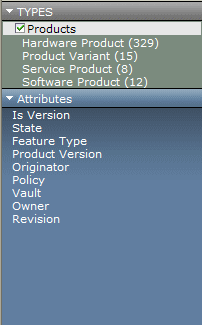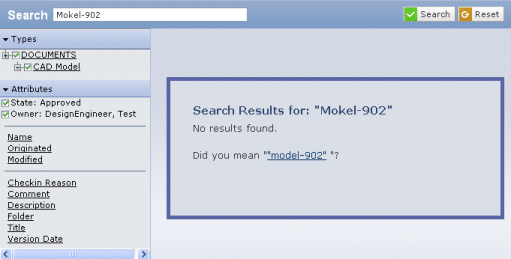Click Search > Product Line from the global toolbar.

The page loads all objects that you can search. Depending on where you initiated the search, the page may have criteria (types and attribute values) that you cannot change. The Results value shows the number of objects found. The value may display like this: Results: 1000 of 89076. If so, your system is configured to limit the number of objects returned. The total count (89076 in this example) is a predicted estimate. By using a prediction instead of an exact count, the results page loads faster. Note:
If you print or export this page, only the results list is included; the Type, Library, and Attribute list is not included.
For each object, this page lists: Name. The object's name. Rev. The revision of the object. Type. The object type, such as Part or Model. Description. The object's description. State. The current lifecycle state for the object.  . Shows this icon if files are checked into or connected to the object. See "Quick File Access" in the Common Components Help. . Shows this icon if files are checked into or connected to the object. See "Quick File Access" in the Common Components Help.
 . Shows the primary image for that object, if defined. See "Image Management" in the Common Components Help. . Shows the primary image for that object, if defined. See "Image Management" in the Common Components Help.
 . Opens a window showing the Properties page for that object. . Opens a window showing the Properties page for that object.
To switch to the form-based search page, click Form Based View. Running an Indexed Search (Form Mode). Not all search pages have this button.
To filter the result list based on a collection, select Collections > and the name of the collection. The results list shows only those objects in the selected collection that meet the criteria. To filter the result list based on object type: If your system includes ENOVIA Library Central, your page may show a Library list below the Types list. Selecting libraries works the same way as selecting types. - Click a type name in the Types list. The Type list is updated to show only the selected type and its children, and the result list is updated to show only objects with that type. Selecting a type is the same as searching for that specific type.

For example, if you click on Products, types that are not Products or children of Products are removed from the list. If you then click on Hardware Product, the list removes all other children types of Products. The check box shows your choices.
- Click a child type to further narrow the list.
- Click a parent type to remove the child type criteria.
To filter the results list based on attribute values: - Click an Attribute name.
If the attribute allows text input, a box opens where you type the needed value. Also, if the attribute contains a numeric value, select a compare operator (== is equals, > is greater than, < is less than) and enter a value. If the attribute contains a range of values, a list box of values for that attribute pops open and you can click the needed value(s)

Some attributes allow you to select more than one value. Use shift-click to select a range of values; use control-click to select individual values. If the attribute contains numbers or dates (and there are many values) you can select Before, After, In Between, or Equals a specified value. Use the calendar tool to enter date values. If there are fewer than a system-set value (the default is 10), the values show as a list. If the attribute contains yes/no values, click the option button for Yes or No. If the attribute includes a unit of measure, enter a value and select the units.
- Click
 . The results are filtered based on objects that have that value for that attribute. . The results are filtered based on objects that have that value for that attribute.
- Continue selecting values for attributes as needed to filter the result list.
To search for specific text in any attribute of an object: - Type the keyword or text string in the Search box.
- Click Search.
- If you see a "Did You Mean?" message, the search tool has found one or more terms that are close to but more common than the one you entered. Click a word or phrase to search for it.

The results section is updated to show objects that contain that text as any attribute value. Note that the search is not case-sensitive and includes in the results all matches based on pieces of the given string. Non-alphanumeric characters are not recognized by the search engine.
To save the search criteria, including the Type and Attribute selections:
-
Click
 > Save As. > Save As.
-
Enter a name for the search, or select an existing search to overwrite it.
- Click Done.
To re-execute a saved search, click  and click the name of the search. and click the name of the search.
To clear all search criteria, click Reset.
To add selected items to a collection, click Collections, and then click:
- Add to Clipboard Collection. Adds the items to your clipboard collection
- New / Add to Collections. Opens the Select Collection dialog. See "Working with Collections" in the AEF Help.
Click Done.
|